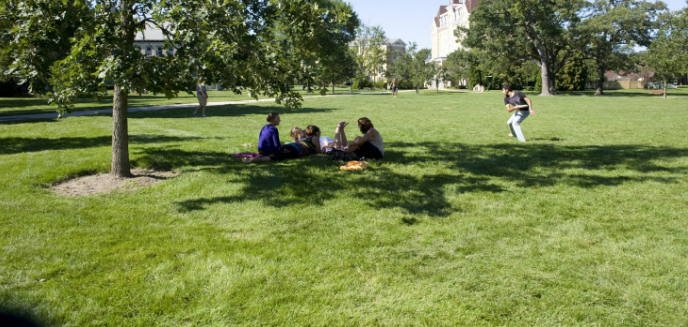Retention Basin to be Built on Middle Campus

In spring 2017, Lake Forest College will build a water garden in the field between Hotchkiss Hall, the Donnelley and Lee Library, and Carnegie Hall.
“When you cover ground, like we are doing with the construction of the science center, the rain needs to have a place to go,” said David Siebert, director of facility management at Lake Forest College. He oversees all the buildings and grounds as well as the College’s construction and renovation projects.
A better name for the said “water garden” is a retention basin, because it will offset the rain as it drains from the new Lillard Science Center and the nearby academic buildings. The consequence of not building a retention basin after the construction of the Science Center would leave large puddles and flooding, killing the grass and leaving a mess throughout the field on Middle Campus.
There is already a retention basin behind Moore Hall and across from the Sports and Recreation Center. This retention basin has been highly effective at draining rainwater since it was built. The rain guard on Middle Campus will be “much bigger than the current one on South Campus,” said Siebert.
“Although there are other ways to relocate the rainwater, this method seems to be the most efficient and visually appealing,” he said. One alternative method would be to dig up the entire field and place large tanks underground to hold the water. Siebert said that method is “a new way of doing things which the city of Lake Forest really likes.”
The retention basin not only keeps the water from where it shouldn’t be, but also filters the rain before it is drained into a pipe underground. Since the field won’t be used, the retention basin will prevent flooding and offer an opportunity for planting. Environmental Studies major, Callie Schaser ‘18, says “Not installing a retention basin will hurt in the long run. The rainwater will kill the grass and cause massive mud puddles if not drained properly. The flooding will also affect the living organisms on the ground.”
The plants will need to be able to survive long periods of drought, since the rainwater will be draining through the ground to the pipes underground, making the plants unable to retain the water. Siebert is working with the rest of the Facilities Management team and faculty from the environmental studies and biology departments to choose varieties that will be most efficient and attractive when construction is complete. The trees surrounded by fences on Middle Campus will remain. The fencing is currently being used to protect the trees as construction continues.
The cost of the water garden won’t be a problem for the College, which sees the installation as necessary in order to keep up with the grounds. Siebert said the garden is “self-sufficient,” so it won’t cost anything to maintain. The only thing that will need to be done is weeding.
Siebert believes a wonderful view will be created once the construction of the rain guard and the Lillard Science Center is finished. “If you stand at the end of the print shop attached to Young Hall, you will see the new Science Center, Carnegie Hall, the rain guard, Hotchkiss, Mohr Student Center, and even Blackstone and Harlan,” he said. “Who knows, it’ll be so nice we’re probably going to have to build something there. Maybe a compass or something.”
